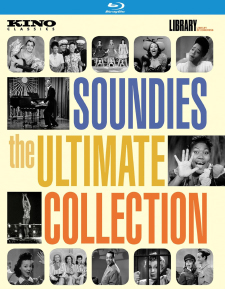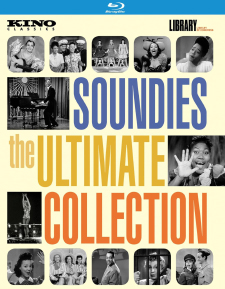Soundies: The Ultimate Collection (Blu-ray Review)

Director
VariousRelease Date(s)
1940-1946 (July 25, 2023)Studio(s)
Library of Congress/UCLA Film & Television Archive (Kino Classics)- Film/Program Grade: A-
- Video Grade: C
- Audio Grade: C
- Extras Grade: A-
Review
“Soundies” were short films of the 1940s that anticipate the music video phenomenon of the 1980s and ’90s, presented in a jukebox format. Produced on 35 mm film by at least seven companies based in New York, Chicago, and Hollywood, Soundies were printed on 16 mm film stock and loaded into “Panoram” movie jukeboxes manufactured by the Mills Novelty Company, based out of Chicago. These machines held eight Soundie films on an endless loop and, for 10 cents, one of these three-minute films would be projected onto a TV-type screen via a system of mirrors.
During the Second World War, Panorams offering Soundies were everywhere—in bars, restaurants, break rooms, in nightclubs, and at amusement parks. The spectrum of popular music of the period was represented: swing, classical, cowboy and hillbilly songs, jazz. Patriotic songs became a big component of Soundies during the war, and (very) short comedy films were also produced: routines by Vaudeville legends Smith & Dale, for instance, while former silent film great Harry Langdon did some of his final work on film in Soundies.
Kino Classics’ Soundies: The Ultimate Collection, produced in cooperation with the Library of Congress and the UCLA Film & Television Library and curated by Susan Delson, is a compact but mammoth region-free, four-disc set of 200 Soundie shorts, some 10 hours of material. Sourcing film elements from the Library of Congress and other archives, using both 35 mm and 16 mm film elements, pictorially the quality of these short films vary widely—the majority being pretty beat-up—but that such obscurities survive at all is rather miraculous.
The back-cover text notes these Soundies include the likes of Duke Ellington and Count Basie, as well future stars Doris Day and Ricardo Montalbán but, for me, even more interesting is the wide range of less familiar talent, performances that, in many cases, survive only on Soundies. So while there are obvious greats like Stan Kenton, “Fats” Waller, Gene Krupa, (Walter) Liberace, The King Cole Trio (featuring Nat), Spike Jones and His City Slickers, Hoagy Carmichael, Dorothy Dandridge, Louis Jordan, the Hoosier Hot Shots, and Cab Calloway, there’s also Carson Robison and Buckaroos, Day Dawn and Dusk, Emerson’s Mountaineers, and Cappy Barra’s Harmonica Boys. The four discs include lots of extra features and there’s also a 44-page booklet with additional essays. Each disc has an overall theme, and each theme is subdivided into additional categories (Going to War, The Home Front, Latin to Staten Island, Heading Toward Rock ‘n’ Roll, etc.).
This segues into the set’s one serious shortcoming: there’s no index of performers or song titles. If you’re looking for a particular song or performer, or want to show friends a particularly outstanding Soundie you watched a couple of weeks earlier, good luck finding it. The only route is to eyeball 17 pages of credits in tiny font contained within the booklet, which admirably provides release dates, producer & director credits, etc. (compiled by Mark Cantor), but everything is listed in the same order as the Soundies on the four discs.
The booklet also offers four well-researched, knowledgeable essays: Movies, Music, Contradictions: Soundies and 1940s America by Susan Delson; Soundies: Music for the Eyes by Mark Cantor; Soundies, Harlem, and the Bricolage of Black Life by Ellen C. Scott; and A Densely Layered History: Black-Cast Soundies and Cultural Change by Delson. There’s also a bibliography and bios of the project’s coordinators.
On the discs themselves you’ll find one or two short featurettes per disc, including introductions by Delson and Ina Archer; Cantor discussing and showing off an original Panoram; and interviewed are Matthew Barton (curator of Recorded Sound at the National Audio-Visual Conservation Center at the Library of Congress) and Mike Mashon (head of the Moving Image Section of the Library of Congress).
Soundies: The Ultimate Collection reminded me of long ago when I’d peruse used record stores for LPs—if those LPs had been randomly packed in shipping crates. But the material contained in this set is invaluable and frequently fascinating. While the lack of proper indexing for so much material is frustrating (and ironic, considering archivists assembled it in the first place), for fans of popular and obscure music from that era especially, this is an outstanding Blu-ray set.
- Stuart Galbraith IV

